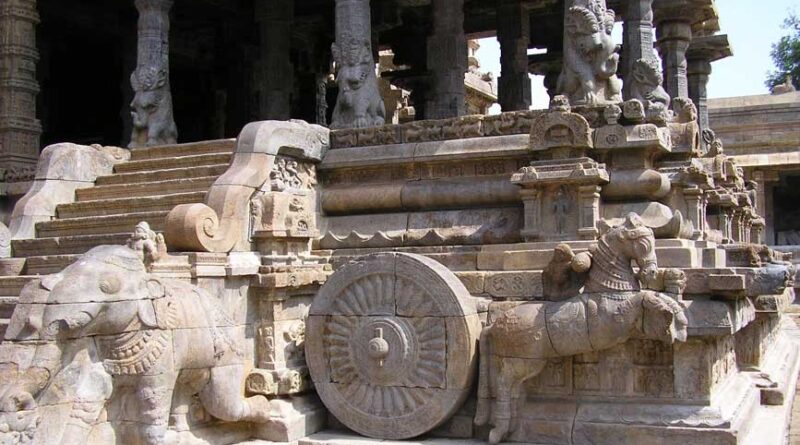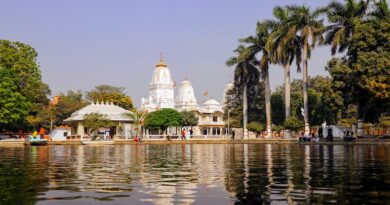Top 10 Ancient Places To Visit In India
India has a great past, a vibrant cultural legacy, and several ancient buildings that draw tourists. Everything about it, from its magnificent architecture to its lovely historical monuments, reflects the majesty of its past and the skill of its artisans. The top 10 well-known ancient sites in India are listed in this article as must-sees.
Our rich tradition and culture are preserved in these historic locations. Visitors from all over the world come to see the beauty and classic appeal of the monuments created during the reigns of the Rajputana, Dravidian, and Mughal kings. Because of their great buildings, the majority of historical locations are recognised by UNESCO as World Heritage Sites.
1.Taj Mahal, Agra
One of India’s most well-known ancient landmarks, the Taj Mahal draws visitors from all around the world. This romantic icon is situated in Agra on the Yamuna River bank. Shah Jahan, the Mughal emperor, erected the ivory-white marble Taj Mahal as a mausoleum in 1632 to honor his wife Mumtaz. The beautiful Mughal architecture is embodied in this UNESCO World Heritage Site. Construction on the monument started in 1632 and was completed in 1648. The marbles came from the Rajasthani city of Makrana. There are gardens, lakes, and fountains all around the main structure of the Taj Mahal. Diagonal tunnels connect the internal octagonal chambers.Screens, calligraphy, and inlay work are used to decorate the main building’s interior and exterior. With elaborate carvings and inlay work using precious and semi-precious gems, it was constructed out of semi-translucent white marble. Egypt, Baghdad, Russia, Golconda, China, Afghanistan, Ceylon, the Indian Ocean, and Persia provided the precious stones for the monument’s inlay. One of the most well-known buildings in the world, the Taj Mahal draws hundreds of tourists every day.
2. Qutub Minar, Delhi
The Qutub Minar in Delhi is praised for being India’s highest minaret. It is also referred to as the “Tower of Victory” at this UNESCO World Heritage Site. The minaret, made of red sandstone and marble, is renowned for its importance in both history and architecture. An illustration of Indo-Islamic architecture can be found in the ancient site in India. The tower was built in three stages, the last of which was completed in 1368 by Firoz Shah Tughlak.Allauddin Khilji, the king of Delhi, added a few things to the building in 1315. On the walls are verses from the Holy Quran written in the Islamic calligraphy style known as Kufic. The 240-foot-tall Qutub Minar was constructed to honor the Muslim rule in northern India. Its premises contain an iron pillar that is more than 2,000 years old and hasn’t corroded. The Qutub Minar has five distinctive floors and a protruding balcony composed of red sandstone and marble. At the base of the tower is a mosque called “Quwwat-ul-Islam Masjid,” which was historically India’s first mosque.
3. Amer Fort, Jaipur
The Amer Palace, also referred to as the Amer Fort, is a significant historical site in Jaipur. Tourists from all over the world come here because of the area’s rich historical past and stunning natural surroundings. To enter the Amer Palace in a regal manner, you can choose to ride an elephant. Prior to Jaipur, Amer served as the state’s former capital. The fort draws inspiration from both Muslim and Hindu architecture. The “Shila Devi” temple and “Ganesh Pol,” a gate leading to the monarchs’ private palaces, are also located in this fort. There are numerous pavilions and halls in the Amer Fort. The four levels of this UNESCO World Heritage Site, which was built with pink and yellow sandstone, each have a courtyard.The Amer fort was established by Raja Man Singh in 1592 AD, and afterwards rebuilt and renovated by Raja Jai Sigh I. This stunning fort has resisted numerous invasions. It is divided into four different sections, each with its own entrance. The “Suraj Pol” or Sun Gate is the Amer Fort’s primary entrance. The “Sheesh Mahal,” “Sukh Mahal,” and “Diwan-i-Aam” (public audience hall) are prominent features of the second courtyard. The marble fresco known as “Magic Flower” is a popular attraction in this area. Diwan-i-Khas, Diwan-i-Aam, Sheesh Mahal, or Mirror Palace, which features mirror mosaics and coloured glass, Jai Mandir, and Sukh Niwas, a complex with natural air conditioning because wind flowed across a water area placed within, are the primary complexes within the fort.Additionally, Jaigarh Fort and Amer Fort are connected beneath by tunnels in Amer Fort. A must-see in Amer Fort is the display of laser lights on the fort’s walls while Rajputana-era tales are told.
4. Ajanta and Ellora Caves, Aurangabad
Among the earliest Buddhist structures and well-known historical sites in Maharashtra are the caves of Ajanta and Ellora. The 29 Ajanta caves were constructed between the second century BC and the sixth century AD. The 34 Ellora caves were created between the sixth and the eleventh centuries AD. It is one of the world’s greatest complexes of rock-cut monastic caves. The masterpieces of Buddhist sacred art found in the Ajanta and Ellora caves, a UNESCO World Heritage Site, have had a profound influence on the development of art in India.Both locations have caves that have been carved out of the volcanic lava of the Deccan plateau. There is a 100 kilometer gap between the caverns. In contrast to Ellora, which focuses exclusively on sculpture and architecture, Ajanta is known for its exquisite Buddhist paintings painted on cave walls. The Ajanta Caves are shaped like a giant horseshoe, with a crescent shape. Four of Ajanta’s 29 Buddhist caverns were utilized as Chaitya, or prayer rooms. The remaining 25 caves were converted into Viharas, which served as residences. The largest monolithic rock-cut temple in the world is the Kailasa temple, which is devoted to Lord Shiva.
5. Konark Temple, Odisha
The Sun god is honored in Konark Sun Temple. The temple is a prime example of beautiful architecture. The Black Pagoda is yet another name for this shrine. Visitors come from all over the world to see this amazing architectural wonder. The stunning 100-foot-long chariot with wheels and ornate horses that has been carved into the temple’s sides is its unique feature. King Narasimha Deva I of the Eastern Ganga dynasty constructed the Konark sun temple, which is now a UNESCO World Heritage Site, in the 13th century. The temple is made of stone and has been sculpted to resemble a chariot with twenty-four wheels and seven horses. It’s carved wheels and geometrical designs are used as sundials. Since the temple faces east, its great entrance was illuminated by the rising sun. Konark is located 65 kilometers southeast of Bhubaneswar and 35 kilometers northeast of Puri. Three different types of stone were used to create the stone temple. Chlorite, Laterite, and Khondalite were utilized in the construction of the temple’s doors, frames, platform, and stairs, respectively. The main temple’s walls are decorated with elaborate carvings, and there is a smaller building called Natya Mandap in front of the temple.
6. Sanchi Stupa, Madhya Pradesh
One of the earliest stone buildings in India was constructed during the Mauryan era and is called Sanchi Stupa. Sanchi is a historical location 46 kilometers from Bhopal in Madhya Pradesh. The Sanchi complex is notable for its Ashokan pillar with its inscriptions, Mahastupa (big stupa), and magnificent torans (gateways). Sanchi is home to sculptures, monuments, and verdant gardens. The Sanchi Stupa measures 120 feet in width and 54 feet in height.The Stupa was constructed during the reign of Emperor Ashoka in the third century BC, and its architecture has “Toranas” that stand for love, peace, courage, and trust. The Stupa’s main hemispherical body represents the cosmic mountain. Its three-layered umbrella-like structure, known as the “Chhatrapati,” serves as a representation of the three jewels of Buddhism—Buddha, Dharma, and Sangha. The Lion capital, located at Sarnath and Sanchi, provided the inspiration for India’s national flag.
7. Gateway of India, Mumbai
Mumbai’s Gateway of India is a magnificent historical structure constructed under British control. It was created to commemorate King George V and Queen Mary’s trip to India. The building’s first stone was placed on March 31, 1911, and it wasn’t finished until 1924. This served as the gateway for western guests arriving during the British era. The 26-meter-high archway is connected by four turrets and features beautiful latticework etched into the stone.Yellow basalt stones are used in the construction of the Gateway of India. The Indo-Saracenic style, sometimes referred to as Victorian Gothic, Hindu, and Islamic architectural styles, are all included into its design. Scottish architect George Wittet created the Gateway of India, a recognisable arch structure.The Gateway of India has a significant historical significance. It marks the location from whence the final British soldier left India. The building is illuminated at night, giving the area a fantastic appearance.
8. Monuments in Hampi, Karnataka
In the fourteenth century, the Vijayanagar empire’s capital was the walled town of Hampi in Karnataka. Over 41.5 sq km, Hampi is home to almost 1,600 monuments, popularly known as the Group of Monuments. Temples, street markets, bastions, treasury structures, and remnants of the Vijayanagar empire can all be found in Hampi, a UNESCO World Heritage Site. The best examples of architectural aesthetics and styles may be seen in Hampi. It is worthwhile to see the Virupaksha Temple, which features a stone statue of Lord Shiva. The Queen’s Bath, the Vijay Vittala temple, the Elephant Stables, and the Hampi Bazaar are some of the additional attractions.
One of the ancient historical sites to see in Hampi is Vittala Temple, also known as Vijaya Temple. Four of the seven musical notes are represented by the 56 musical pillars, also known as SaRiGaMa Pillars, in the Vijaya Vittala shrine. When tapped with a thumb, the pillars emit musical notes. This reflects an outstanding architectural marvel and is the actual architectural genius of Hampi. The use of stones in the columns’ construction is what I find most interesting. For tourists who enjoy art and history, Hampi, which has a history dating back 1,400 years, is a must-visit location.
9. Victoria Memorial, Kolkata
One of the most visited historical sites in Kolkata, West Bengal, is the Victoria Memorial, commonly referred to as Victoria Memorial Hall. The Victoria Memorial monument-cum-museum serves as a symbol of the city’s colonial and architectural past. One of Kolkata’s main tourist attractions is this lavish mausoleum built of marble that is tucked away among lush gardens. The Indo-Saracenic revivalist architectural style, a synthesis of Mughal, British, Egyptian, Islamic, and Venetian components, is displayed at Victoria Memorial. Viceroy of India Lord Curzon is the creator of the Victoria Memorial. Curzon suggested constructing a large memorial in her honor after the death of Queen Victoria, the British empress, in January 1901.The Prince of Wales, who later became King George V, laid the cornerstone for Victoria Memorial on January 4, 1906. At the summit of the memorial, a 16-foot-tall bronze statue of victory mounted on ball bearings adds to the complex’s majesty. In 1921, the structure opened to the public for tours. The building, which is made of white Makrana marble, is 103 by 69 by 56 meters in size. There are 25 galleries there, including the National Leaders Gallery, Calcutta Gallery, Portrait Gallery, Royal Gallery, and others. More than 28,000 objects, including paintings, weapons, textiles, and more, are housed in the Victoria Memorial Museum.
10. Khajuraho, Madhya Pradesh
An historic city in Madhya Pradesh called Khajuraho is now a UNESCO World Heritage Site. The temples of Khajuraho, the former capital of the Chandela Dynasty, are renowned for being among the finest examples of medieval Indian architecture in the Nagara style. Most of the Khajuraho temples were built between 950 and 1050 AD. The statues of nayikas and gods found at the “Khajuraho Group of Monuments” are well known. According to historical documents, there were 85 temples in the Khajuraho temple site in the 12th century (in 20 sq km about 25 temples have lasted, spread over six sq km).Among the still-existing temples, Kandariya Mahadeva Temple has sculptures with elaborate detailing, ancient Indian art symbolism, and expressiveness. The fact that the Khajuraho temples were jointly devoted to Hinduism and Jainism suggests a heritage of tolerance and respect for all religions. Although the temples are known for their sensual carvings, they also display a celebration of love, life, and adoration. Less than 10% of the sculptures on the complex of temples are sexual in nature, while the majority of them show scenes from people’s daily lives.





amazing places😁